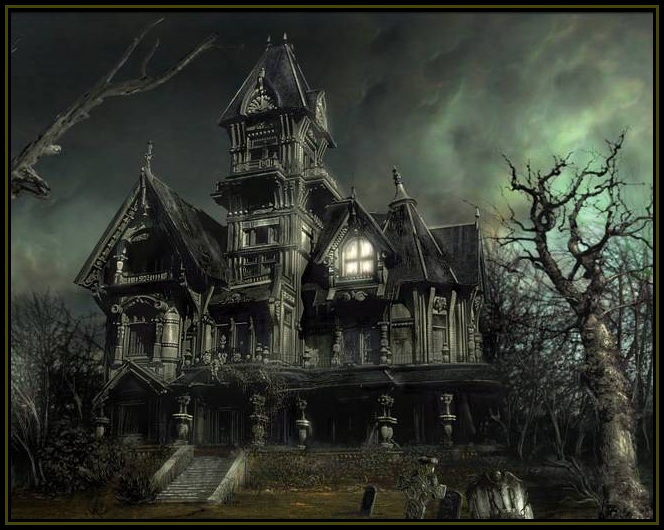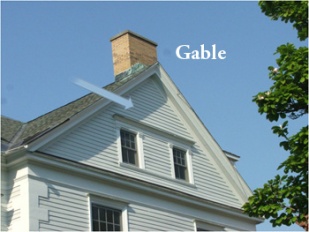 Think real hard – what’s the scariest work within haunted house literature?
Think real hard – what’s the scariest work within haunted house literature?
Think even harder – what is the funniest work of the haunted house genre?
Think harder than “even harder” – which haunted house book best captures the spirit of today’s youth?
Think so hard that your brain bleeds – which haunted house novel has the best graphic illustrations?
Tired of all this thinking? Good, because I am going to give your brain a rest by dumbing things down a bit as I get into the subject of today’s review – Archie’s Haunted House (Archie & Friends All-Stars), which, by the way, is not the crowning achievement for any of the above categories. Truth is, I don’t know which haunted house novel is the scariest, funniest, trendiest or “graphiciest” (the superlative of “graphic.” See I.. oh never mind, just read on!) But it’s not Archie’s Haunted House, but we love Archie anyway. Why? Because he is Archie! (circular reasoning notwithstanding)
Maybe some of you don’t know what an “Archie” is. Archie is the star of fictional comic book series about teenagers who do “teenage-ish” things in the small town or Riverdale. He’s been around since – My god! Really Wikipedia? Since 1941? And here I thought he was the byproduct of the late fifties and early sixties with all that soda- shop/sock hop kind of humor. The all-American teenage Archie, with red hair and all, had a side kick named Jughead, known for his laziness and addiction to junk food. Archie dated either blonde Betty ,the sweet, girl-next-door, or brunette Veronica, the snobby rich girl. Then there was Reggie the conceited one, Big Moose the dimwitted but good-hearted jock, Dilton the brainy nerd. The list goes on.
Archie has survived over the decades, has gone through various incarnations for multiple publications. As previously mentioned, there’s the “sock-hop” era Archie, there’s “Little Archie” (the teenagers as children), there was even “Christian” Archie. Archie tried (but in my opinion, failed miserably) to stay with the times. In the 1980’s he was saying no to drugs, in the 1990’s he was listening to grunge rock – you get the idea. In a parallel universe of Archie (the Life with Archie series),the Archie gang appear as superheroes, secret agents. They marry each other. In one story, poor ol’ Archie dies. But he lives in one of the other 2,343,120 Archie publications (number may be slightly exaggerated.)
As a birthday gag-gift, my friend and colleague gave me this haunted house issue of Archie from 2010. He knows I dig haunted house stuff and he also knows that I am familiar with The Archie comics. I read it and thought “why not ‘review’ it.” But the sum of the review is as follows – “It’s Archie” – more of that circular reasoning for ya!
In the first story, a costume store opens in Riverdale. The costumes are special in that the person who puts them on becomes what they are wearing. Archie is running around Riverdale as a werewolf, Reggie a vampire, etc. It takes nerdy Dilton to break the spell of these magical costumes and return the gang back to normal
The second story is about the oldest house in Riverdale. It’s supposed to be haunted, but  the city council sees it only as an eye sore and wants it torn down. But wait! Archie discovers the house is an important piece of history and wants it preserved. But wait again! It really does turn out to be haunted and Archie changes his mind and wants it torn down – after convincing the council to preserve it. Oh brother!
the city council sees it only as an eye sore and wants it torn down. But wait! Archie discovers the house is an important piece of history and wants it preserved. But wait again! It really does turn out to be haunted and Archie changes his mind and wants it torn down – after convincing the council to preserve it. Oh brother!
In the third tale, the girls are having a “girl-only” Halloween party and the boys come to scare them. It turn out that the boys become the ones who are scared when they mistakenly conclude that Veronica’s aunt is an axe murderer.
Finally, there’s my favorite story! Archie and Jughead, dressed as vampires, miss Veronica’s Halloween party, and so they are invited to another party – at a haunted house. In attendance are real monsters. There are mummy ladies and werewolf women, There are things with many eyes, there are ogres. There’s even a medusa. When these monsters discover that Archie and Jughead are not real vampires, they are in trouble!

If you want to know the truth, I prefer the Archie comics of the 1960’s and 1970’s. My older sisters had a bunch of these lying around the house when I was growing up. I read em’ and dug em’. I cringe when the comics go out of the way to show how much they have moved with the times. In Archie’s Haunted House, Veronica and Betty discuss a Pearl Jam concert. In 2010 I think it would be a little late for that. Later, they succumb to a magic spell, and the writers compare the trance they fall into to the reactions the girls typically have after watching Brad Pitt on the screen. I would think B and V as teenagers of 2010 would go more for Robert Pattinson of Twilight. That would definitely fit – since these are horror-themed stories.
Ah but oh well. My colleague has told me that Archie comics have always thrown in references to real people and places aimed at referencing the “current times.” I’ll take his word for it; I just don’t remember the older issues being so obvious about it while simultaneously being a decade off track.
Anyway, this is a fun comic book. Not really scary, not “ha ha ha” funny, and I’m not sure who the target audience is. It can’t be today’s millennials, they won’t go for this. And I would guess that many middle-aged folks (like me) and beyond would prefer the older issues. The drawings are decent. That’s good, right? Despite the shortcomings, it’s an enjoyable read. I don’t know why. Oh wait, yes I do – it’s fun because it’s “Archie”



 AAAAAAA-BBAHHHHHHET!!!!
AAAAAAA-BBAHHHHHHET!!!! 

 well and its surrounding land.
well and its surrounding land. The tables have turned. Costello, as a ghost, pulls tricks on Abbott and nearly drives him out of his mind. He disturbs his sleep by playing the harpsichord. He lights his cigarette, but Abbott doesn’t see Costello- he only sees a lighter hovering in the air. He gives him a good kick in the ass over a chair! You go Costello!
The tables have turned. Costello, as a ghost, pulls tricks on Abbott and nearly drives him out of his mind. He disturbs his sleep by playing the harpsichord. He lights his cigarette, but Abbott doesn’t see Costello- he only sees a lighter hovering in the air. He gives him a good kick in the ass over a chair! You go Costello! There’s an accepted adage that one should ‘never judge a book by its cover.’ Sorry Mr. Adage, but that is exactly what I am going to do. Not only am I going to judge the cover, but I an going to evaluate the paper, fonts, and even the box it came in. I am going to offer my opinion on the illustrations as well. And my opinion is this = Saul Goodman. (it’s all good, man!) Oh and the story is all right as well.
There’s an accepted adage that one should ‘never judge a book by its cover.’ Sorry Mr. Adage, but that is exactly what I am going to do. Not only am I going to judge the cover, but I an going to evaluate the paper, fonts, and even the box it came in. I am going to offer my opinion on the illustrations as well. And my opinion is this = Saul Goodman. (it’s all good, man!) Oh and the story is all right as well.


 could almost feel the warmth from the fireplace and nearly hear it crackling. Could my mind hear the eerie chanting rituals that arise from the cellar? I think so. Could it see all the way up to the top of the library tower, where hidden in the shadows of the rafters was some kind of phantom? I believe so.
could almost feel the warmth from the fireplace and nearly hear it crackling. Could my mind hear the eerie chanting rituals that arise from the cellar? I think so. Could it see all the way up to the top of the library tower, where hidden in the shadows of the rafters was some kind of phantom? I believe so.





 PINNACLE
PINNACLE formed by two sections of the roof sloping down.
formed by two sections of the roof sloping down.

 MANTEL
MANTEL
 MANACLES
MANACLES
 BALUSTRADE
BALUSTRADE

 The Haunting of Blackwood House
The Haunting of Blackwood House Fame! Fortune! Power! Pleasure! – these things are the gods of this world, so sayeth a religion teacher I knew many moons ago. These are the lower-case gods; false gods, gods that are appetizing to the flesh but poisonous to the soul. I’ll add a few more – Beauty! Youth! In sum, these gods represent an overwhelming lust for “the good life.”
Fame! Fortune! Power! Pleasure! – these things are the gods of this world, so sayeth a religion teacher I knew many moons ago. These are the lower-case gods; false gods, gods that are appetizing to the flesh but poisonous to the soul. I’ll add a few more – Beauty! Youth! In sum, these gods represent an overwhelming lust for “the good life.” has generously shared the contents of his mind with us so that we may also get a glimpse of this macabre world. Now there are some (and you may be one of them) that do not want any part of Clive Barker’s imagination. This is understandable, for there are sensitive folks out there. Barker graphically describes the human anatomy and the situations that arise when one piece of anatomy meets another. He also describes the anatomy of things that are not human. For instance, there is this goat boy (who happens to be the son of Satan) that is quite often visibly aroused. I’ll leave it at that.
has generously shared the contents of his mind with us so that we may also get a glimpse of this macabre world. Now there are some (and you may be one of them) that do not want any part of Clive Barker’s imagination. This is understandable, for there are sensitive folks out there. Barker graphically describes the human anatomy and the situations that arise when one piece of anatomy meets another. He also describes the anatomy of things that are not human. For instance, there is this goat boy (who happens to be the son of Satan) that is quite often visibly aroused. I’ll leave it at that.